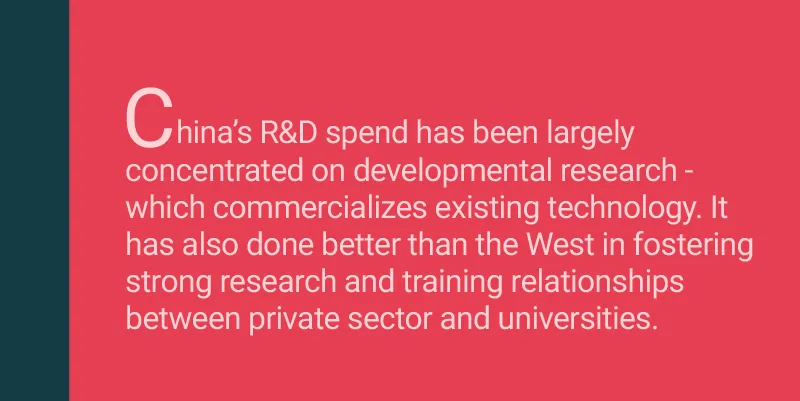The 4 factors that have propelled the innovation boom in China
China has cracked the innovation code by getting the basics right, including creating the pre-requisites to foster originality, focusing on unique market characteristics, and increased government support.
Last month, taking in the sights of Milan on a spring afternoon, I was greeted by what has become a familiar sight for me over the past few months in Shanghai. Rows of neatly arranged orange bicycles dotting several tram stations. These were the offerings from Mobike, a unique dock less bike-sharing startup founded in Beijing three years ago.
Interestingly, bicycle sharing as a public transportation solution has its origins in Amsterdam in the 1960s, and has been quite prevalent in the West before its arrival in Asia in the first decade of the 21stcentury. However, conceiving an enterprise that gives customers the freedom to choose where to pick and park their cycles, a digitised payment and customer service interface, and a reward system that incentivises responsible behavior are distinctly Chinese business innovations. These have - in the last three years - been brought in by dozens of Mobike-like bike-sharing firms rapidly expanding outside their native country.
Pick up any book on Chinese business written even five years ago, and chances are that the country’s competitive strength will be ascribed to its imitative capacity and cost advantage. If I were to bring someone living in 2010 to the streets of Milan and ask them about these bikes on the streets, chances are that they would have guessed these bikes were made in China, but would be genuinely surprised to know that the process innovations that make the riders’ experience so unique are also Chinese.

Indeed, even as late as March 2014, Abrami, Kirby and Macfarlan in an article in Harvard Business Review mentioned a litany of reasons for why China cannot innovate. It is not that those problems have all gone away, but they have been offset by a confluence of gradual and progressive reform undertaken over the past one and a half decade.
As is the case with every successful and innovative economy, some of the factors behind this success have been cultural, certain others circumstantial and, most importantly, a significant contribution to this progress has also been political.
My purpose with this series of articles is to bring to you such unique examples of indigenous innovations in China, the factors that have enabled their development, the risks that they face, and the transferability of some of their aspects in India’s context.
Freeing the cities from the Emperors and Satraps
In my view, there are four essential factors that have enabled the explosion of innovation in China. The first, and perhaps the least acknowledged, is administrative organisation. When it began the process of economic reform in 1978, China quickly realised that to convincingly win the argument in favour of privatisation, it needed to create small but successful test cases – where opening up of the economy would lead to a rapid advance in employment opportunities and living standards.
Pearl River Delta, which includes Guangdong and Shenzhen, was chosen as the first site of this experiment in 1979. Importantly, more than just granting the cities of Pearl River Delta the usual subsidies that are given to Special Economic Zones all over the world, the central government allowed the city government full autonomy in matters of economic policy and law, so long as they met certain economic goals of the party, in terms of growth and employment each year. The momentum was continued with administrative reforms that created prefecture-level cities and sub-provincial cities, whose mayors were empowered, sometimes as in the case of Shanghai, at par with provincial governors, with the seats at the highest echelons of the Communist Party decision-making bodies.

The crux of reform, when it comes to innovation, is the way in which the central government separated these cities from the control of largely rural provinces, which had been based on a command-based economy and allowed them to apply innovative developmental policies. Furthermore, with this separation, the city governments (37 presently) are also freed from sharing their revenues with the former provinces they were a part of, and can keep a large share of sales of land assets and deploy them in the development of urban infrastructure. Moreover, the government also allocates subsidies and policy incentives to these cities, based on their developmental performance, and encourages them to compete with each other to attract market access.
City governments are not torn between the dilemma of balancing growth between old industries, agriculture, and new high-tech sectors. Furthermore, as the only resource available for them to meet their economic targets, given the high density of their population and small size, is human capital, they have consistently invested in developing supplier clusters, skilling workers, and adopting new technology, which has fostered innovation.
For India, this is instructive. Most of our biggest and most innovative cities are capitals of large states – Mumbai for Maharashtra, Bengaluru for Karnataka - where power is vested with provincial governments whose political priorities focus on a large and predominantly rural electorate. But of course, the powers of mayors in our country are nowhere close to those enjoyed by their counterparts in China.
Getting the simple things right
China did simple things right when it came to creating the pre-requisites for fostering innovation. Between 2000 and 2014, the number of science and engineering graduates went up four times, from 359,000 to 1.65 million. Furthermore, research and development efforts at universities were also very closely aligned with the needs of industries. As of 2014, 34 percent of Chinese grants to R&D at university level came from the private sector. The corresponding share in the US was just 5 percent as per National Science Board’s numbers for the same year.

This also tells us a lot about the priority given to research in China. Since 2006, when the government announced its “indigenous innovation” policy, China’s research efforts at university levels have focused on development research, which is focused on commercialising already proven technologies for the market. For example, integrating LED displays within clothing, or using near-field communication to improve last-mile GPS abilities.
In its April 2017 report on innovation in the US manufacturing sector, BCG estimated that China’s investment in developmental research is likely to be double that of the US in 2018. With venture capital commitment of US$50 billion in 2016 equaling that of the US, the high-risk capital, often the last piece in the innovation ecosystem, is also now falling in place. That said, much of the disruptive innovation in AI, ecommerce, and industry 4.0 is still being driven by entrepreneurs and investors with a significant experience of having studied and/or worked in the US. Teaching methods at home rank poorly compared to those abroad and often discourage curiosity. Yet, rich university and industry linkages and a large pool of students to choose from make it easier for maverick entrepreneurs to hire middle managers and use the intellectual resources of the academia.
What makes China innovate?
Third, the unique characteristics of the Chinese market – a large domestic demand and a policy-induced clustering of special economic zones – made them better at innovations in industries where customer focus and open collaboration across the supply chain yield the highest profit margins. It is not a surprise then that the crown jewels of China’s startup space are concentrated in consumer electronics (Haier, Xiaomi), ecommerce (Alibaba), internet finance (Ant Financial), construction (Sany), telecom equipment (Huawei), and commercial drones (DJI). In this context, it is important to understand that China’s startup ecosystem is a bit of a wild west – IPR regulations are much weaker than those in developed countries, consumer trust is gained hard but quickly lost, and the extreme differences in consumer behavior between Chinese buyers and the West makes any external business model non-transferable without alterations.
Succeeding in such circumstances requires an intimate and continuous dialogue with customers to develop better products. That’s how Alibaba overcame the natural buyer-seller mistrust and undercut eBay by offering an escrow system that only paid the seller once goods were received by the buyers. Or the reason why Tencent puts such an intense focus on building “walled gardens” on its platform Wechat, which for its customers is PayPal, Slack, Facebook Messenger, Venmo, Tinder, You Tube, Instagram, and Swiggy all rolled into one.

Furthermore, commercialisation of an innovation or successful deployment of a business process doesn’t happen in isolation. A mobile phone maker needs to understand the latest developments in chip-making technology to understand what features can be introduced in his latest upgrade. Similarly, a consumer drone maker’s competitive advantage doesn’t come only with an accurately positioned GPS system but also on pushing his suppliers to incorporate the latest advances in material technology and circuit design. As per a 2015 report by McKinsey, more than a 1,000 electrical, materials and electronics manufacturing firms can be found within a two-hour driving radius within the Pearl River Delta. This deep network of suppliers, a vast B2B cloud infrastructure, and the close proximity of complementary firms in China’s cities are the reasons behind the success of giants such as Huawei, DJI, or Xiaomi.
A communist state that believes in startups
Finally, the recent explosion in innovation and the increased government support to private sector through subsidies and state-owned venture capital also has strategic dimensions. By 2012, when President XI Jinping took control of the Chinese economy, the country had already exhausted, what Schumpeter called “the latecomer’s advantage”. Labour costs had risen, and the ability of further investment to stimulate GDP (the so-called Incremental Capital Output Ratio) had begun to decline sharply; China’s time as an economy that simply piggy-backed on scientific and commercial breakthroughs made by the developed world was limited.
Rebalancing the economy away from the investment heavy, state-owned industries in steel, mining and manufacturing towards services sector, as the government aimed in its 12thfive-year plan in 2013, required a new economic model. Furthermore, a new source of employment had to be created for the millions of people who would lose their jobs once the state started shutting down its loss-making factories in the traditional industry. These imperatives drove an otherwise conservative Chinese government to adopt a light-touch regulatory approach towards new industry – especially in ecommerce, AI, personal services, and consumer finance.

Recently, the focus of public investment has moved towards developing basic research capabilities as well – the state plans to directly invest close to US$12.1 billion in artificial intelligence and quantum computing by 2020. Some results of that investment in innovation were visible last year, when Face ++, owned by Beijing-based firm Megvii, beat teams from Facebook, Google, and Microsoft to win the International Conference of Computing Vision 2017.
In its ambitions, China’s investment in state-backed basic research is similar to the efforts consistently made by DARPA and NSF in the US to encourage technological breakthroughs. Much as the development of internet, through DARPA grants in the 1970s created new industrial segments and changed the way we do business, consistent and focused investments by China in AI and quantum computing have a similar disruptive potential.
Like Khaleesi’s children, the dragon will one day cross the sea
How does this impact us in India? First, as the global economy moves towards the age of Internet of Things (IoT), where devices communicate with each other, China will have a natural advantage given the rapid advances that it has made in deep learning and its traditional strengths in agile manufacturing. Second, businesses that have grown by making a billion users their customers need another billion users to make them grow as much. As Bloomberg reported a few weeks ago, China’s smartphone market has likely topped out - with smartphone shipments actually falling in 1Q 2017 by about 21 percent y-o-y (though they should recover somewhat later this year). Cost of customer acquisition in-house has also risen, to the extent that salesmen from popular online gaming and O2O apps (personal services like spa, maid service etc.) are often seen on Shanghai subway stations distributing leaflets and vigorously exhorting customers to subscribe to them.

India, so far, has been an obvious business destination for a number of Chinese B2B firms in machinery and light manufacturing. However, the next crop of Chinese businesses to target India as a market could be those that are highly customer focused. This could play out in many ways – China’s BAT (Baidu, Alibaba, and Tencent) could pursue an aggressive acquisition strategy to win local markets, or they could set up local business development and R&D centres in India, in the same way as GE and Bosch did a couple of decades ago.
But more interestingly, given the stark differences among the consumers in two countries, and the relative inexperience of China’s new economy giants in services sector of expanding beyond their borders, they could also offer an opportunity for Indian startups to learn through competition and grow through a better understanding of their customers than their foreign companies. However, any such development would require the massive institutional reforms in administration, R&D spending and infrastructure that have laid the foundation of China’s innovation ecosystem.
Stay tuned for the next article on this special series on China, only on YourStory.com.
(Disclaimer: The views and opinions expressed in this article are those of the author and do not necessarily reflect the views of YourStory.)







